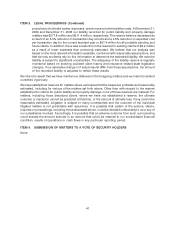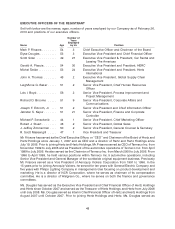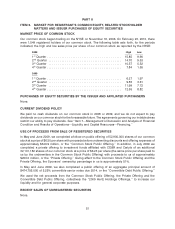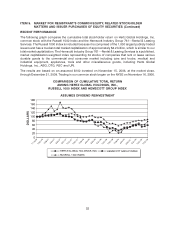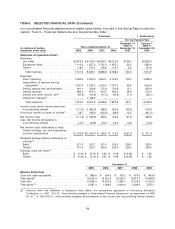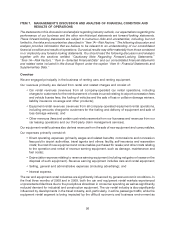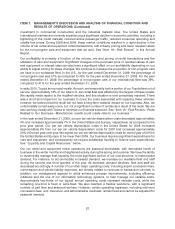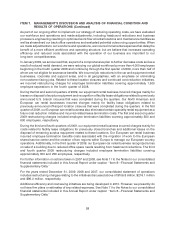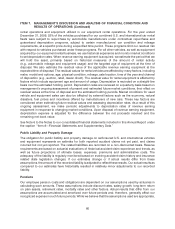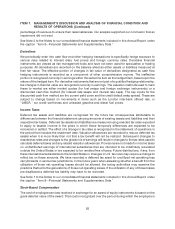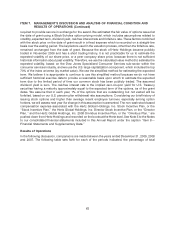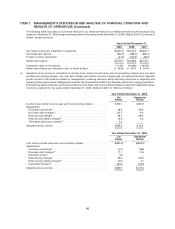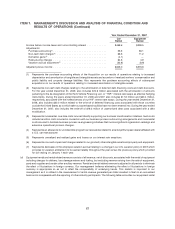Hertz 2009 Annual Report Download - page 77
Download and view the complete annual report
Please find page 77 of the 2009 Hertz annual report below. You can navigate through the pages in the report by either clicking on the pages listed below, or by using the keyword search tool below to find specific information within the annual report.ITEM 7. MANAGEMENT’S DISCUSSION AND ANALYSIS OF FINANCIAL CONDITION AND
RESULTS OF OPERATIONS (Continued)
investment in commercial construction and the industrial markets slow. The United States and
international markets are currently experiencing a significant decline in economic activities, including a
tightening of the credit markets, reduced airline passenger traffic, reduced consumer spending and
volatile fuel prices. During 2008 and 2009, these market conditions resulted in a rapid decline in the
volume of car rental and equipment rental transactions, soft industry pricing and lower residual values
for the non-program cars and equipment that we sold. See ‘‘Item 1A—Risk Factors’’ in this Annual
Report.
Our profitability is primarily a function of the volume, mix and pricing of rental transactions and the
utilization of cars and equipment. Significant changes in the purchase price or residual values of cars
and equipment or interest rates can also have a significant effect on our profitability depending on our
ability to adjust pricing for these changes. We continue to increase the proportion of non-program cars
we have in our worldwide fleet. In the U.S., for the year ended December 31, 2009, the percentage of
non-program cars was 51% as compared to 45% for the year ended December 31, 2008. For the year
ended December 31, 2009, the percentage of non-program cars in our international fleet was 39%,
compared to 41% for the year ended December 31, 2008.
In early 2010, Toyota announced recalls. As such, we temporarily took a portion of our Toyota fleet out of
service. Approximately 13% of our total U.S. car rental fleet was affected by the largest of these recalls.
We rapidly made repairs to the recalled vehicles, and this situation is now completely resolved. There
was a short-term impact on our business to cover the costs associated with repairing these vehicles;
however, we believe that this recall will not have a long-term material impact on our business. Also, we
unfortunately turned away some, but not a significant number of rentals as a result of the recall. We are
also working closely with Toyota to minimize our financial exposure. See ‘‘Item 1A—Risk Factors—Risks
Related to Our Business—Manufacturer recalls could create risks to our business.’’
In the year ended December 31, 2009, our per car vehicle depreciation costs decreased approximately
4% and increased approximately 7% in the United States and Europe, respectively, as compared to the
prior year period. Our per car vehicle depreciation costs in the United States for 2008 increased
approximately 6% from our per car vehicle depreciation costs for 2007 and increased approximately
20% in Europe year-over-year. We expect our per car vehicle depreciation costs for the full year of 2010 in
the United States and Europe to be lower than 2009. Our business requires significant expenditures for
cars and equipment, and consequently we require substantial liquidity to finance such expenditures.
See ‘‘Liquidity and Capital Resources’’ below.
Our car rental and equipment rental operations are seasonal businesses, with decreased levels of
business in the winter months and heightened activity during the spring and summer. We have the ability
to dynamically manage fleet capacity, the most significant portion of our cost structure, to meet market
demand. For instance, to accommodate increased demand, we increase our available fleet and staff
during the second and third quarters of the year. As business demand declines, fleet and staff are
decreased accordingly. A number of our other major operating costs, including airport concession fees,
commissions and vehicle liability expenses, are directly related to revenues or transaction volumes. In
addition, our management expects to utilize enhanced process improvements, including efficiency
initiatives and the use of our information technology systems, to help manage our variable costs.
Approximately two-thirds of our typical annual operating costs represent variable costs, while the
remaining one-third is fixed or semi-fixed. We also maintain a flexible workforce, with a significant
number of part time and seasonal workers. However, certain operating expenses, including minimum
concession fees, rent, insurance, and administrative overhead, remain fixed and cannot be adjusted for
seasonal demand.
57


